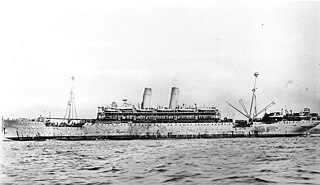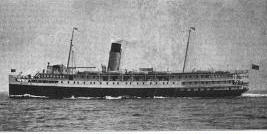
A steamship, often referred to as a steamer, is a type of steam powered vessel, typically ocean-faring and seaworthy, that is propelled by one or more steam engines that typically move (turn) propellers or paddlewheels. The first steamships came into practical usage during the early 1800s; however, there were exceptions that came before. Steamships usually use the prefix designations of "PS" for paddle steamer or "SS" for screw steamer. As paddle steamers became less common, "SS" is assumed by many to stand for "steam ship". Ships powered by internal combustion engines use a prefix such as "MV" for motor vessel, so it is not correct to use "SS" for most modern vessels.

USS Pocahontas (SP-3044) was a transport ship for the United States Navy during World War I. She was originally the SS Prinzess Irene, a Barbarossa-class ocean liner built in 1899 by AG Vulcan Stettin of Stettin, Germany, for the North German Lloyd line.
Steamship Princess Victoria was a luxury passenger ship built in 1902 and operated by the Canadian Pacific Railway Company. Subsequently, converted into a bulk oil carrier under the name Tahsis No. 3, the ship struck a rock and sank on 10 March 1953.
Princess or Prinzess Irene may refer to:

CP Ships was a large Canadian shipping company established in the 19th century. From the late 1880s until after World War II, the company was Canada's largest operator of Atlantic and Pacific steamships. Many immigrants travelled on CP ships from Europe to Canada. The sinking of the steamship RMS Empress of Ireland during World War I was the largest maritime disaster in Canadian history. The company provided Canadian Merchant Navy vessels in World Wars I and II. Twelve vessels were lost due to enemy action in World War II including the largest ship sunk by a German U-boat, RMS Empress of Britain.

The fifth SS Rotterdam, also known as "The Grande Dame", is a former ocean liner and cruise ship, and has been a hotel ship in Rotterdam, the Netherlands, since 2010. She was launched by Queen Juliana of the Netherlands in a gala ceremony on 13 September 1958, and was completed the following summer. The Rotterdam was the last great Dutch "ship of state", employing the finest artisans from the Netherlands in her construction and fitting out process. Her career spanned forty-one years. She sailed from 1959 until her final retirement in September 2000.

History Is Made at Night is a 1937 romantic drama with elements of comedy and spectacle.

RMS Sylvania was an ocean liner built in 1957 by John Brown & Co (Clydebank), Glasgow, Scotland for the United Kingdom-based shipping company Cunard Line. She was the last Cunard Line vessel built specifically for transatlantic crossings. The ship was later heavily rebuilt as a cruise ship, and sailed under the names SS Fairwind, SS Sitmar Fairwind, SS Dawn Princess and SS Albatros before being scrapped in 2004. She was renamed SS Genoa for her last voyage.

USS Princess Matoika (ID-2290) was a transport ship for the United States Navy during World War I. Before the war, she was a Barbarossa-class ocean liner that sailed as SS Kiautschou for the Hamburg America Line and as SS Princess Alice for North German Lloyd. After her World War I Navy service ended, she served as the United States Army transport ship USAT Princess Matoika. In post-war civilian service she was SS Princess Matoika until 1922, SS President Arthur until 1927, and SS City of Honolulu until she was scrapped in 1933.
SS Princess Alice may refer to:
The United States Mail Steamship Company – also called the United States Mail Line, or the U.S. Mail Line – was a passenger steamship line formed in 1920 by the United States Shipping Board (USSB) to run the USSB's fleet of ex-German ocean liners that had been seized by the United States during World War I or awarded as war reparations after the end of the war. Receivers were appointed for the line after financial improprieties and massive losses came to light. After review of the financial data, a United States District Court ordered that all the U.S. Mail Line ships be returned to the USSB.
The Los Angeles Steamship Company or LASSCO was a passenger and freight shipping company based in Los Angeles, California. The company, formed in 1920, initially provided fast passenger service between Los Angeles and San Francisco. In 1921, LASSCO added service to Hawaii in competition with the San Francisco-based Matson Navigation Company using two former North German Lloyd ocean liners that had been in U.S. Navy service during World War I. Despite the sinking of one of the former German liners on her maiden voyage for the company, business in the booming 1920s thrived, and the company continued to add ships and services. In 1922, the City of Los Angeles, a renamed and refitted liner was one of the largest American ships sailing in Pacific waters. The worsening economic conditions in the United States, and the burning of another ship in Hawaii, caused financial problems for the company. After beginning talks in 1930, the Los Angeles Steamship Company was taken over by Matson Navigation on January 1, 1931, but continued to operate as a subsidiary until it ceased operations in 1937.

The SS Princess Kathleen was a passenger and freight steamship owned and operated by Canadian Pacific Steamships. She served the coastal communities of British Columbia, Alaska and Washington.

SS Princess Alice was a passenger vessel in the coastal service fleet of the Canadian Pacific Railway (CPR) during the first half of the 20th century.

SS Princess Adelaide was a passenger vessel in the coastal service fleet of the Canadian Pacific Railway (CPR) during the first half of the 20th century.

SS Princess Mary was a passenger vessel in the coastal service fleet of the Canadian Pacific Railway (CPR) during the first half of the 20th century.

Typaldos Lines, formally known as the Aegean Steam Navigation Company, was a privately held Greek shipping company based in the port of Piraeus, Greece. In 1956 the company had registered its headquarters in London, UK. after operating earlier as Typaldos Brothers Steamship Co. Ltd. The company purchased retired ships and refitted the vessels for passenger cruises and ferry services in the Mediterranean and Greek islands. In 1966 the ferry SS Heraklion sank in the Aegean Sea and over 200 passengers and crew members perished. In 1968 the Greek government investigation of the Heraklion incident found the ship's owners guilty of manslaughter, negligence, and document falsification. Furthermore, twelve of the company's fifteen ships had failed inspection. Haralambos Typaldos and Panayiotis Kokkinos were sentenced to jail. The company was dissolved that year when their ships were taken over or sold.
The SS Princess Louise was a 331-foot steamship, named in honor of Louise, Princess Royal and Duchess of Fife, Queen Victoria's granddaughter. The ship was part of the Canadian Pacific Railway's "Princess" fleet, the coastal counterparts to CPR's "Empress" fleet of passenger liners which sailed on trans-Pacific and trans-Atlantic routes. The ships of the British Columbia Coast Steamships came to be called "pocket liners" because they offered on smaller vessels the superior class of service, splendid amenities and luxurious decor equal to great ocean liners.
The Pacific-Alaska Navigation Company was an American passenger and freight ocean shipping company that operated between 1912 and 1916 on the West Coast of North America. It was formed as a holding company during the merger of the Alaska Pacific Steamship Company and the Alaska Coast Company. During its four years of life, its fleet became known as the Admiral Line because its ships were usually named for former U.S. Navy admirals. The company was operated by president H.F. "Bert" Alexander, a former Tacoma longshoreman who worked his way up the ranks.











